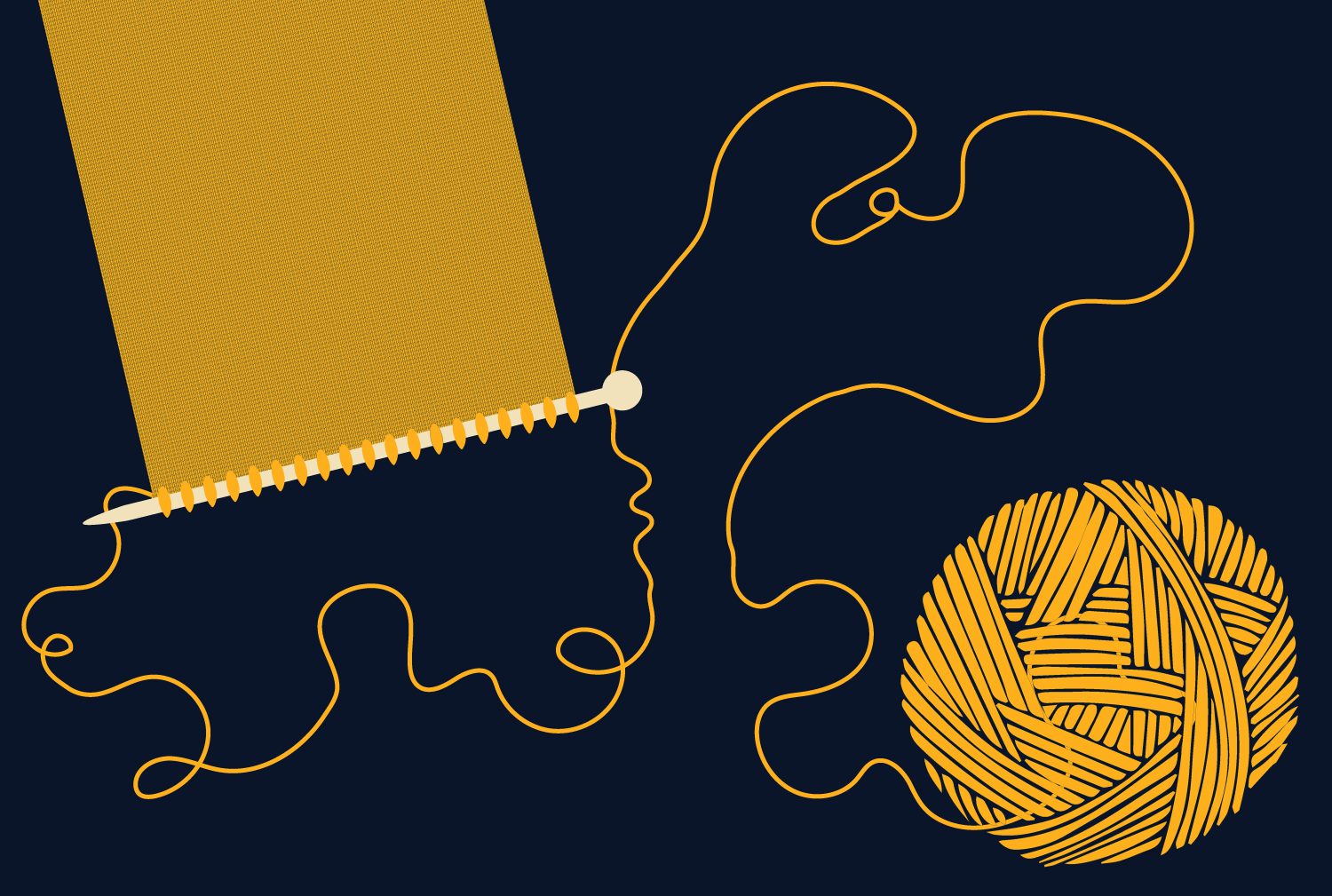 Scroll
Scroll
An Incomplete Survey of Fictional Knitters
June 1st, 2021 | Issue one hundred thirty-six
The craft of knitting is such a prominent literary act that a subgenre of literature—called “knit-lit”—has formed. Within this subgenre, there are several motifs, including what is colloquially referred to as “the sweater curse”: the idea that when someone knits a garment for their love interest, the act will seal the demise of their relationship. Knitting a garment by hand is a deeply intimate act, which perhaps explains why authors are attracted to its symbolic potential. Knitting also has an unassuming quality. The act evokes peace and domestic tranquility, and it is often employed to convey these sentiments. A knitter can become a vehicle for change, too, propelling a story forward through their handicraft. A character may weave intricate narrative webs, sometimes suggesting warmth or safety, and other times disguising the places where heartbreak, deceit, and evil may lie. If you look for them, you’ll find them—somebody in the corner, knitting a hat or a scarf, quite possibly something containing the depths of their affections or, just as probable, the names of the people they wish dead.
—Zeynab Warsame


Dr. Seuss, The Lorax:
The Once-ler goes against the Lorax’s wishes and deliberately cuts down every last Truffula tree, decimating the environment in the process, in order to knit and sell Thneeds, in-demand and versatile garments.


Charles Dickens, David Copperfield:
Affectionately referred to simply as “Peggotty” (which is another word for a knitting loom, or a “knitting Nancy”), Clara is the warm and caring housekeeper frequently found knitting in her idle time.


Louisa May Alcott, Little Women:
The March sisters knit as part of their household duties, which is a point of contention for Jo March: “I can’t get over my disappointment in not being a boy… and I can only stay at home and knit, like a poky old woman!”


Charles Dickens, A Tale of Two Cities:
Madame Defarge knits her revenge by encoding in her creations the names of those she wishes to die by guillotine. She is reminiscent of the Greek Fates, who measured man’s lifespan by a length of yarn, the cutting of which symbolized death.


Joseph Conrad, Heart of Darkness):
Marlow spots two women who “knitted black wool feverishly” when he arrives at the Company’s office, another possible symbolic gesture toward the Greek Fates, and foreshadowing the end of Marlow’s journey.


Agatha Christie, multiple works:
Detective Miss Marple uses knitting as a cloak of innocence when in the midst of a risky investigation.


Jane Austen, Emma:
Emma notes her irritation with Jane and her rambling about her personal knitting projects, finding them deeply uninteresting: “If she does but send her aunt the pattern of a stomacher, or knit a pair of garters for her grandmother, one hears of nothing else for a month.”


Jane Austen, Persuasion:
Mrs. Smith is taught to knit by her nurse, and it becomes a source of joy for the unlucky woman: “As soon as I could use my hands, she taught me to knit, which has been a great amusement; and she put me in the way of making these little thread-cases, pin-cushions, and card-racks…”


J. K. Rowling, Harry Potter:
Molly, mother to all, knits Weasley sweaters as annual gifts for friends and family—usually with their initials knit onto the front.


J. K. Rowling, Harry Potter:
Hermione knits socks and hats for house-elves as part of her philanthropic endeavors for elf rights and welfare.


Charles Addams, The Addams Family:
Morticia is an avid knitter, frequently shown with needles and fabric in hand. Her creations always lean toward the unique and vaguely disturbing, like her three-legged baby’s onesie.


Virginia Woolf, To the Lighthouse:
The question of whether or not the weather will permit the Ramsays to venture to the lighthouse opens the novel. While knitting a stocking for the lighthouse keeper’s son, who is ill with tuberculosis, Mrs. Ramsay muses that they will indeed make it there.


Leonard Cohen, Book of Longing:
In a grotesque turn, Cohen both laments and welcomes the loss of a love in the poem “This Is It”: “I’m going to put a knitting needle / up my nose / and poke out my brain / I don’t want to love you / for the rest of my life.”


Thomas Hardy, Far from the Madding Crowd:
Heartbroken, Bathsheba, once an avid knitter, rejects the hobby when it is suggested to her as a source of comfort for her romantic woes. “O no, no! I hate needlework—I always did,” she states. When asked, “Knitting?” she replies, “And that, too.”


Leo Tolstoy, War and Peace:
Anna displays her creations, specifically a pair of stockings, which she knits using a method known as double-knitting. Her ability to create two pieces at once dazzles the Rostov children, as it is “a secret process known only to herself.”


James Baldwin, Giovanni’s Room:
David describes his aunt Ellen and her penchant for knitting at the opening of the novel: “Or she knits. It seems to me that she was always carrying a great bag full of dangerous-looking knitting needles, or a book, or both. And I don’t know what she knitted…”


Willa Cather, My Ántonia:
Lena is a seamstress and sometimes knitter, who, despite winning the affections of many men, refuses to marry, preferring her independence: “bareheaded and barefooted, scantily dressed in tattered clothing, always knitting as she watched her herd.”




